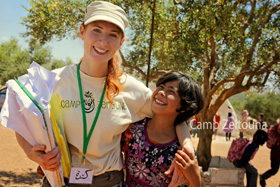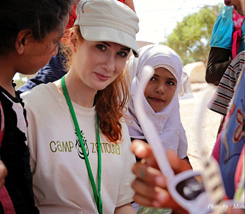 She considers herself an artist and a humanitarian. However, when Kinda Hibrawi ’96 began Zeitouna, she became a woman of all trades.
She considers herself an artist and a humanitarian. However, when Kinda Hibrawi ’96 began Zeitouna, she became a woman of all trades.
In 2013, after a Greek museum made budgetary cuts and cancelled an exhibit of her paintings, Ms. Hibrawi co-founded Zeitouna, a program of creative workshops for refugee children in Syria and Turkey. During these weeklong periods, she and her team use art, sports, and creative writing to help these children heal from the wounds of being torn away from their homes and forced to grow up in a refugee camp.
How and when did you come up with the idea for Zeitouna?
It’s an interesting story where, out of despair, comes hope. I came across a documentary on HBO called “Sing your Song,” a biography of Harry Belafonte. I had no idea of his philanthropic work, the things he did for Africa, and the awareness he brought. I remember being so inspired at the end of it and thinking, “Why isn’t anyone bringing this awareness to Syria?”
I emailed a family friend who had recently traveled to the refugee camps and pitched my idea of bringing art workshops to kids in Syria. I had previous experience with art workshops through the Children’s Hospital in Orange County and I began an art therapy program in Irvine, CA. I wanted to bring creativity to these kids while documenting what these refugees look like and what they were going through. We started brainstorming and the program took on a life of it’s own. We started in March and by June we were there in the camps working with the children.
Did the reality of the refugee camp match anything you imagined before arrival?
No. Almost everything that you read in the news is not true. What I was seeing on TV in the States did not look like what I knew of Syria or Syrians. The coverage was very violent and dark, not that the situation wasn’t, but I felt like there was no other side to the news. It was unfair to be a witness and not have both sides.
How are you incorporating your art, and your love of art, into Zeitouna?
My art has definitely taken a back seat, but I enjoy teaching the kids. I call one of the workshops I’m running right now the calligraphy frog workshop. The kids write down their names, as nicely as possible in Arabic calligraphy, and I teach them how to turn that paper into an origami-jumping frog. The kids really love the frogs because they jump. I’m hoping to collect 1,000 frogs and link them all by string and have a similar project to the 1,000 Japanese cranes.
Now that Zeitouna is well established, what are your plans for the future?
We started with six volunteers in June and now we have 35 traveling with us in December. With the support we have now we plan on making the trip twice a year, in the summer and the winter.
Our goal is to publish and sell a catalogue of the kid’s art, photographs, and stories, the profits of which would go back to the program. Ideally a book tour would follow, hitting major cities like D.C., New York, and L.A.
Who was your favorite teacher at Williston?
Hands down, Marcia Reed, she was the biggest influence in my art career and in my life. She introduced me to the world of painting, what it means to be a painter, and about acrylic paints. I’m an acrylic painter now because of her. She wasn’t just my teacher; she was my mentor.
Read more about Zeitouna, a Karam Foundation project, in this article written by the co-founder and a Karam Foundation president, Lina Sergie.

